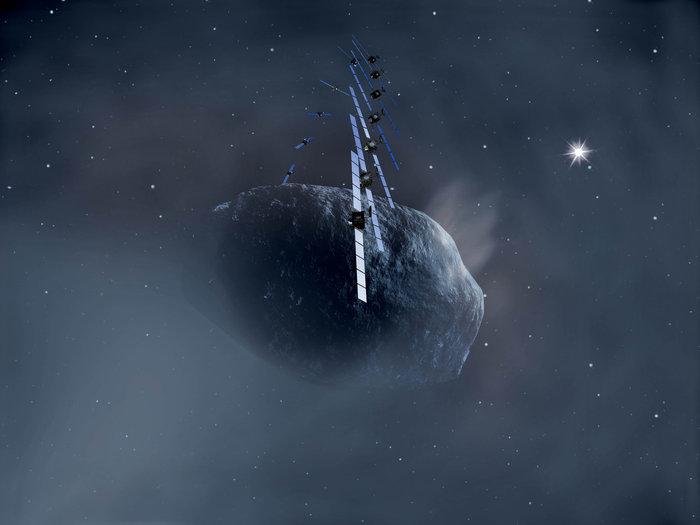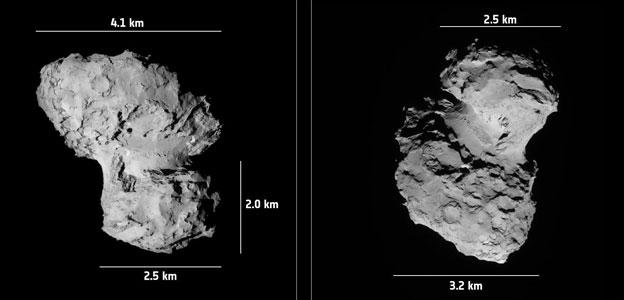Most people can’t resist the pull of space exploration, although most of us are content to be armchair astronauts. New discoveries in outer space inspire our imaginations and the greater the inspiration, the greater the likelihood that space exploration continues to get much-needed funding to persist. The Hubble Telescope, launched in 1990, to date, the most versatile and the largest of space telescopes, has been a major source of just such inspiration.
Now, Rosetta, the European Space Agency’s (ESA) so-called “comet chaser,” launched in March 2004, is capturing the most detailed ever images of a comet. For ten years. the orbiter has trawled the Solar System. In the spirit of the most riveting space adventure, Rosetta crossed an asteroid belt and continued on into deep space, according to the ESA, which is collaborating with NASA, traveling more than “five times Earth’s distance from the Sun.”
Rosetta has a specific destination: the comet, 67P/Churyumov-Gersimenko, most often referred to as “67P.” The orbiter has been flying in close vicinity to 67P since August of 2014, getting within 10 kilometers (a little over 6 miles) and has captured detailed photographs allowing U.S. and European scientists to take some amazingly precise measurements of the icy terrain of the comet.
This week ESA released a model of 67P as well as the dimensions they’ve arrived at thus. Using specs provided by the ESA, space enthusiasts can now 3D print their own models of the famous comet, whose asymmetrical shapes approximates that of a duck. NASA’s Rosetta site provides a 3D rendering and links to the data-set for printing 3D in .wrl and .obj formats. The site also provides information such as the gases detected, sizes of dust grains found, the spin axis, the water vapor production rate, and surface and subsurface temperature of 67P–minus 68C to minus 43C and minus 243C to minus 113C respectively.
Measurements will hopefully be refined and more information will be acquired when Rosetta lands on the surface of 67P this coming November 12 in the afternoon (European time). From 464 million kilometers away, we’ll find out, among other things, just how reflective of light the comet actually is but scientists working on the project have remarked that its color is “blacker than black.” Rosetta’s camera, called “Osiris,” has provided such information. The ESA’s printed model is light gray as there was evidently little concern with accuracy in this regard until further data is available.
Rosetta will make its revolutionary comet landing thanks to the Philae lander, on which it piggybacks in order to set down. The landing process will take a tense seven or so hours and the Rosetta, basically a high-tech robot will be aimed at the smaller portion of 67P, which is estimated to be around 2.5 by 2.5 by 2.0 kilometers in dimension.
It took a couple of months for scientists to release the data-set that may now be used to 3D print models of 67P. While certainly heightening the intrigue, there are some practical reasons for waiting for what must have seemed like ages for outsiders: this is exciting and groundbreaking work that will, among other things, represent tremendous career-achievement (among other things) for ESA team members and their NASA collaborators.
The fact is, we have never gotten this close to a comet before and scientists believed we’ve only just scratched the surface. As portions of 67P are in permanent darkness, there is going to be some educated speculation about certain dimensions, but if the November Rosetta landing is successful, be prepared to 3D print an updated version of the comet as version one will be a rough, preliminary version and hopelessly out-of-date even just a few months later. It will also, evidently, be the wrong color so you may want to stock up on black filament for your printer. Isn’t that part of the beauty of cutting-edge scientific discovery, though?
Let us know if you have printed out your own replica of 67P in the 3D printed comet forum thread on 3DPB.com.
Subscribe to Our Email Newsletter
Stay up-to-date on all the latest news from the 3D printing industry and receive information and offers from third party vendors.
You May Also Like
Air Force Awards Fortius Metals $1.25M to Qualify 3D Printing Wire for Hypersonic Applications
AFWERX, part of the US Air Force Research Laboratory (AFRL), awarded a Direct-to-Phase II Small Business Innovation Research (SBIR) contract worth $1.25 million to Colorado’s Fortius Metals, to accelerate qualification...
US Air Force Awards JuggerBot $4M for Large-format Hybrid 3D Printing
Large-format 3D printer manufacturer JuggerBot has received a $4 million grant to develop a large format 3D printer, courtesy of the Under Secretary of Defense, Research and Engineering Manufacturing Technology...
Where Have All AM’s Unicorns Gone?
In the rapidly evolving world of 3D printing, startups valued at over a billion dollars, known as unicorns, once seemed as fantastical as the mythical creatures themselves. While a few...
How My Childhood Fascination with Planes Led to Investing in 3D Printing
My fascination with aerospace started young, and I started studying planes–identifying them in the sky and learning everything I could about how they work. Fast forward to my first week...

































